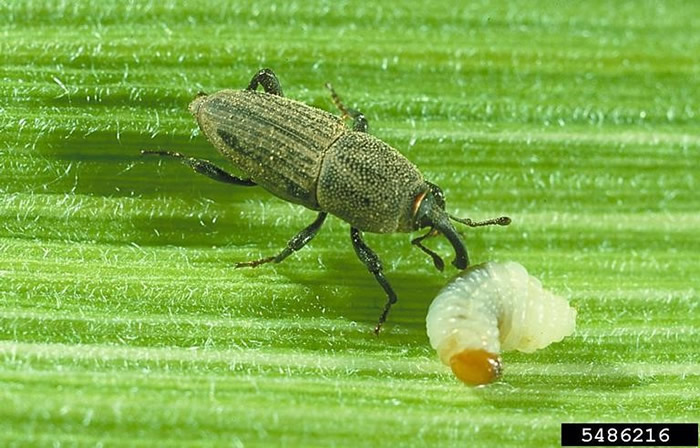Issue 9, August 24, 2020
Billbugs
Adult billbugs are small weevils, about 3/8 of an inch long. They can range from brown to black in coloration and have the distinct long snout and hard wing covers that are characteristic of weevils. Adult billbugs spend much of their time in the soil, feeding on grass roots. When they are above ground, they usually do not fly and may be seen walking along driveways and sidewalks. Because they do not fly, billbug damage usually does not spread to new areas.
Adults chew holes in grass stems where they lay eggs. After hatching, billbug larvae begin to tunnel and feed within the grass stems and rhizomes. They eventually emerge from the plants into the soil where they feed on the roots. Billbug larvae are white and C-shaped. They are easily differentiated from white grubs because they are leg-less and much smaller, measuring up to ½ an inch. They may be difficult to locate because of their cryptic behavior.

Bluegrass billbug (Sphenophorus parvulus) adult and larva, David Shetlar, The Ohio State University, Bugwood.org.
Adult billbugs usually do not cause noticeable injury to turfgrass but the larvae can cause significant feeding damage. Billbug injury appears as browning, straw-like turf in two to three inches round patches. To differentiate billbug injury from that of other insects, you can use the “tug test.” If the injured turf is pulled, it will break easily. The individual grass plants will have holes in the stems and small brown pellets of frass may be found around the stems of the grass plants. If 10 or more billbug larvae are found per square foot of turfgrass, action can be taken to control the insect and prevent further injury.
Injury from billbug larval feeding usually becomes visible in late July and early August. However, the best time to treat for billbugs is in early June, while larvae are young. By August, the larvae begin moving into their pupal phase. As pupae, billbugs will no longer feed on the grass and will not take in a treatment applied at that time.
Chemical controls for billbugs include chlorantroniliprole (Acelepryn) and trichlorfon (Dylox) provide control within a few days. Chlorantroniliprole poses a lower risk to pollinators than many other chemical controls and trichlorfon can be used in areas where a short-acting pesticide is preferred. Longer acting, systemic insecticides including imidacloprid (Merit), clothianidin (Arena) and thiamethoxam (Meridian) may take a couple of weeks to control the insects but will persist within the plants for some time. It is important to avoid applying neonicotinoid insecticides to lawns that have a mix of turfgrass and clover, to protect the bees and other pollinators that visit the flowers.
Nematodes that attack larvae, such as Heterohabditis bacteriophora, can provide good protection in a few days and may be more effective on more mature larvae. Nematodes will provide about 60% control while chemical controls may provide 95% control. Both options provide good protection since the insects do not need to be completely eradicated from the area to prevent economic damage.
Author:
Sarah Hughson